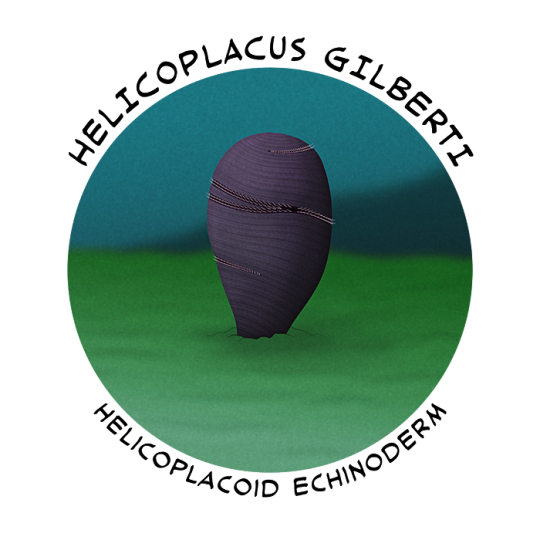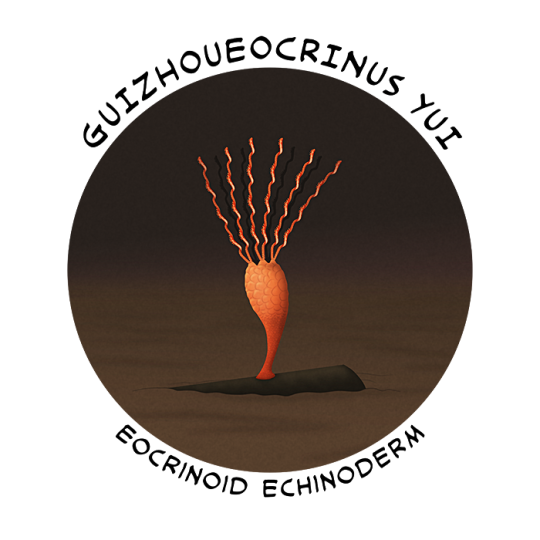#blastozoa
Explore tagged Tumblr posts
Text
Strange Symmetries #04: Even More Echinoderms
Early echinoderms seem to have gone through an asymmetrical phase before starting to evolving their characteristic radial symmetry. The first truly radial forms had three-way symmetry, but soon a group called the edrioasteroids upped that count to five.
First appearing in the fossil record around 525 million years ago in the early Cambrian, edrioasteroids were mostly shaped like discs or domes, and were immobile filter-feeders that lived permanently attached onto surfaces like the seafloor or the shells of other animals. Unlike most modern echinoderms their pentaradial symmetry was actually created by taking a tri-radial body plan and forking two of their arms near the bases to create a total of five.

Thresherodiscus ramosus was an unusal edrioasteroid that lived in the shallow seas of what is now central Canada during the late Ordovician, around 460-450 million years ago. Up to about 4cm in diameter (~1.6"), its arms split additional times at irregular intervals, creating a complex asymmetrical branching pattern across its upper surface.
The tips of its arms protruded slightly over the rim of its body, and along with the erratic extra branching this may have been an adaptation to increase its food-gathering surface area.
———
Another group of early pentaradial echinoderms known as the blastozoans were characterized by erect feeding appendages called brachioles. But some blastozoans abandoned their five-way symmetry in favor of much stranger arrangements, sometimes having as few as two arms – and, in some cases, two mouths.

Known from the same general area and time period as Thresherodiscus, Amygdalocystites radiatus was part of an Ordovician-to-early-Silurian lineage known as paracrinoids, which attached their irregularly-shaped bodies to the seafloor via a stem.
About 5cm long (~2") Amygdalocystites had just two asymmetric arms forming "food grooves" along its upper edge, each lined with numerous long brachioles along just one of their sides. It probably orientated itself so its body was facing down-current, which would have created eddies that brought suspended food particles within easier reach of its brachioles.
———
NixIllustration.com | Tumblr | Twitter | Patreon
#science illustration#strange symmetries#paleontology#paleoart#palaeoblr#thresherodiscus#edrioasteroid#amygdalocystites#paracrinoid#blastozoa#echinoderm#art#eldritch echinoderms
266 notes
·
View notes
Text

Gogia
Gogia — рід примітивних еокріноїдних бластозоїв з раннього до середнього кембрію.
Повний текст на сайті "Вимерлий світ":
https://extinctworld.in.ua/gogia/
#gogia#cambrian#cambrian period#silurian#north america#utah#eocrinoidea#canada#british columbia#usa#echinodermata#blastozoa#paleontology#paleoart#extinct animals#prehistoric#scientific#prehistory#science#creatures#illustration#tumblr#ukrainian#daily#палеонтологія#палеоарт#ukraine#українська мова#art#україна
2 notes
·
View notes
Photo

Sarah gave a talk titled, ‘Quantitatively assessing gross morphology of holocystitid diploporitans: Blastozoa, Echinodermata’. Long and tricky title. Essentially, a fossil collector in the Cincinnati region - Tom Bantel - found a ton of this very specific kind of fossil called a diploporitan. These fossils were restricted to certain amount of time in the Paleozoic - so about 450-400 million years ago. In the fossil record we think about aging or growth in terms of size. The biggest fossils of a certain species we find is often the adult, meaning everything smaller is a different growth stage. Obviously - this is a HUGE assumption and is not always true. There are other telling signs on ancient echinoderms that help us determine if the fossils are ‘adults’ or not. We essentially go through a check list of assumptions and our understanding of their shape and growth.
Maggie and I used a laser scanner to create 3D models of all of these specimens from Tom. Sarah and (other) Jen could then clean up these models and put a bunch of little points on them with a few as ‘anchors’ or places where we know are the same on each fossil. Then they used morphometric analyses to see if there is a way to quantitatively describe how this animal grew! It was really a fun project with so many different collaborators! I was really glad to be a part of it.
Check out her abstract: QUANTITATIVELY ASSESSING GROSS MORPHOLOGY OF HOLOCYSTITID DIPLOPORITANS (BLASTOZOA: ECHINODERMATA)
Also, Sarah is a new faculty at the University of South Florida - if you like echinoderms and evolution check out her faculty page, she will be looking for new graduate students for Fall 2020: http://hennarot.forest.usf.edu/main/depts/geosci/faculty/ssheffield/
#paleontology#paleobiology#science#scicomm#gsa2018#conference#morphometrics#echinoderm#ancient#fossils
0 notes
Photo

While most modern echinoderms display the group's characteristic five-way symmetry, there were plenty of much much stranger-looking forms back during the Paleozoic.
And some of the most confusing of them were the paracrinoids, which evolved an incredibly diverse range of body shapes during their group's relatively short 40 million year existence during the Ordovician.
Despite the name these echinoderms weren't particularly closely related to true crinoids, instead being part of a completely extinct lineage known as the blastozoans. Their ancestors had been radially symmetric, but paracrinoids largely abandoned that body plan, instead developing irregularly shaped and often asymmetric bodies ranging from round to flattened. They had between two and five "food grooves" on their upper surfaces, derived from the ambulacra, lined with numerous feeding appendages along only the left side of each.
They were shallow-water animals, living either attached to the seafloor by a long stem or anchored into the sediment by a shorter one, suspension feeding with their appendages and transporting the food particles towards the mouth located between the bases of the food grooves.
(…And speaking of mouths, some paracrinoid species appear to have had two of them.)
Heckerites multistellatus here lived around 458-445 million years ago, during the Late Ordovician. It inhabited the then-subtropical seas of the Baltica region, with fossil material known from what is now Estonia, southeastern Norway, and northwest Russia.
About 10cm tall (4"), it lived on the seafloor in sheltered waters protected from strong waves by large reefs, and is unusual even among its weirdo relatives for features such as retaining feeding appendages on both sides of its food grooves – although irregularly arranged and with fewer on one side than the other. Its body was shaped rather like a flattened bean, with two food grooves diverging from roughly the centre of the top margin, chunky skeletal plates forming a border around its edges, and a short stem at is base.
It also had an unusually large "anal pyramid" on the opposite side of its body from its mouth, and this may have been used for respiration as well as waste expulsion, similar to modern sea cucumbers.
———
Nix Illustration | Tumblr | Pillowfort | Twitter | Patreon
#science illustration#paleontology#paleoart#palaeoblr#heckerites#paracrinoidea#blastozoa#echinoderm#invertebrate#art#a literal weird-ass echinoderm#eldritch echinoderms
258 notes
·
View notes
Photo


Cambrian Explosion Month #12: Phylum Echinodermata – Radial Revolution
While many of the earliest echinoderms had bizarre asymmetrical forms, at some point members of their lineage adopted radial symmetry instead – a development that would eventually lead to the familiar five-way symmetry of most modern species.
And they may have transitioned to that via three-way symmetry.
Helicoplacus gilberti is known from California, USA, and dates to around 525 million years ago. About 7cm tall (2.75"), it had what appears to be three feeding grooves on a body twisted around into a spiralling cigar shape, and it would have lived standing upright with its base buried into soft muddy sediment or microbial mats.
As one of the oldest definite echinoderms in the fossil record, for a long time it was thought to be an extremely "primitive" basal form possibly ancestral to all other groups in the phylum. Its confusing anatomy didn't help, with debates over the location of its mouth and whether its twisting body was really triradially symmetric or not, but more recent studies have suggested it was actually much closer related to modern echinoderms than to the weird asymmetrical ones.
The discovery of a closely related species named Helicocystis shows a potential transitional form between helicoplacoids and pentaradial echinoderms – a spiral Helicoplacus-like body, but with five feeding grooves, and a small attachment stalk at its base that resembles those of early five-rayed groups like eocrinoids.
This would also mean that all the early echinoderm lineages diverged from their common ancestors even more rapidly than previously thought, developing body plans ranging from bilateral to asymmetric to pentaradial within just a few million years in the early Cambrian.
———
Eocrinoids were some of the first pentaradial echinoderms to have both attachment stalks and erect feeding appendages, and were the ancestral members of a group called the blastozoans, but it's not clear if they were actually ancestors or close relatives of modern crinoids. Traditionally crinoids are thought to have evolved from blastozoans, but other studies suggest their similarities might be convergent and crinoids could instead be descended from another group called edrioasteroids.
Guizhoueocrinus yui was an early eocrinoid with a vase-shaped body and a thick stem. Known from southwest China, about 516-513 million years ago, its five arms split into pairs of spirally coiled appendages near their bases, giving it a total of ten.
It grew to around 6cm tall (2.4"), and spent its life filter-feeding while attached to hard surfaces on the sea floor, such as the shells of brachiopods, trilobites, and hyoliths – possibly while some owners of the shells were still alive, and sometimes with multiple individuals found on the same shell.
Another potential link between Helicoplacus and early pentaradial echinoderms also comes from Guizhoueocrinus, with evidence of a "crypto-helical" spiral arrangement of its skeletal plates.
The eocrinoids were the most diverse and successful echinoderms during the Cambrian, and went on to survive until the late Silurian, while other blastozoans descended from them lasted up until the end-Permian mass extinction 250 million years ago. (…Unless crinoids are blastozoans, in which case some descendants of eocrinoids are still alive today.)
———
Nix Illustration | Tumblr | Pillowfort | Twitter | Patreon
#science illustration#paleontology#paleoart#palaeoblr#cambrian explosion 2021#echinoderm#helicoplacus#guizhoueocrinus#gogiida#eocrinoidea#blastozoa#ambulacraria#deuterostome#bilateria#eumetazoa#animalia#art
86 notes
·
View notes
Photo

Syringocrinus paradoxicus from the Upper Ordovician of North America (~450 mya). Measuring up to around 6cm long (2.3″), it was part of an extinct group of marine animals known as solutes -- characterized by irregularly-shaped bodies covered in calcite armor plates, the structure of which suggest they were echinoderms despite their complete lack of any proper symmetry.
It had two appendages, one a short “arm” that was probably used for feeding on food particles suspended in the water, and the other forming a longer stalk-like “tail” that may have served to propel it along the seafloor.
Solutes were once thought to be closely related to the equally weird-looking stylophorans, but some versions of the echinoderm family tree place them much further apart, suggesting their superficial similarities may have been due to convergent evolution instead.
#science illustration#paleontology#paleoart#palaeoblr#syringocrinus#echinoderm#solute#carpoid#homiostelea#blastozoa#invertebrate#art#these things are almost ALIEN#kind of but not QUITE bilaterally symmetrical#go home evolution you're drunk
251 notes
·
View notes